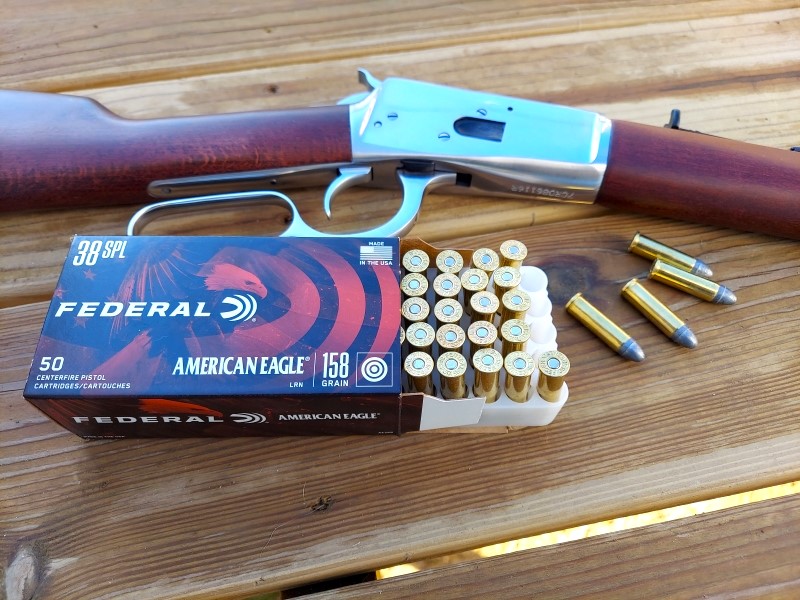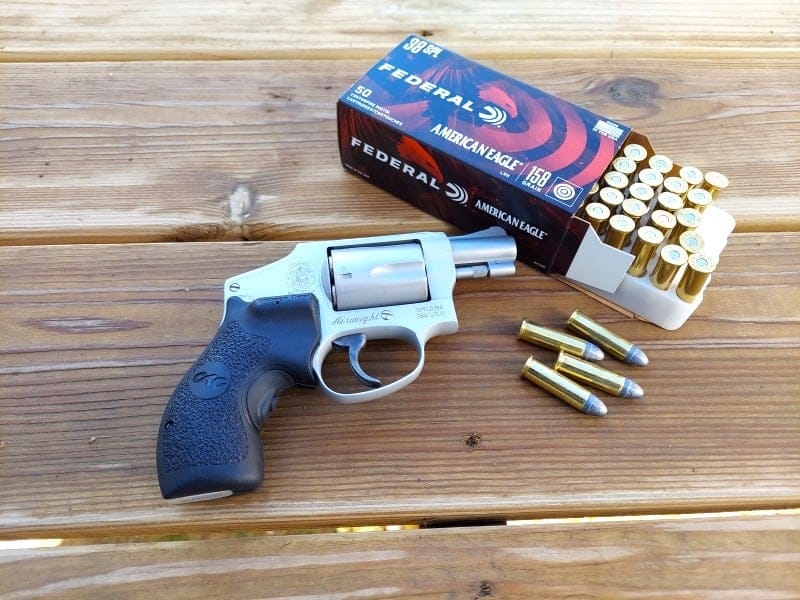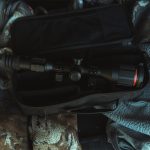Federal .38 Special Lead Round Nose — Smooth Feeding Target Ammo

My experience with Federal Ammunition harkens back a few decades. As snipers for our state law enforcement agency, we were always issued Federal ammunition (and also for our duty weapons most of the time). Federal Match 168 grain boat-tail hollow-point ammunition proved to be 100% reliable in our sniper rifles, as well as incredibly accurate. We never had an issue with it, and it gave completely reliable performance.
In my personal weapons, I’ve used Federal for decades too. One of my favorites has been their Hydra Shok line of ammunition, especially for my 9mm handguns.
.38 Special 158 Grain Lead Round Nose
Recently, I received some 158-grain lead round nose target ammo in .38 Special for testing. It is their American Eagle line, which I’ve used for years and which has proven to be very reliable. I’ve never experienced a misfire with it, nor had any other issues.
The ammunition arrives in a 50-round box, which is standard for most pistol ammunition. This ammunition is categorized as “Practice” ammunition for the range.
Considering its solid, lead, round nose construction, it wouldn’t be a great choice for defensive purposes, although, at one time, my agency actually issued this round to us as duty ammunition.
The projectiles are loaded into brass cases, which can then be used for reloading if desired. Another nice aspect is that this ammunition is made in the USA. It’s always good to support American companies.
Federal lists the muzzle velocity from a four-inch barrel on this ammunition as 770 feet per second. This is not surprising, given that it’s among the heavier .38 Special loads out there.
The Test Guns
I used two guns to test this ammunition. The S&W 642 Airweight revolver and the Rossi R92 lever action carbine.
S&W 642
The 642 is a lightweight revolver with an alloy frame. The barrel and cylinder are stainless. The hammer is enclosed, commonly referred to as “hammerless,” which is great for drawing because there’s no hammer to snag. What’s more, it can be fired from inside a pocket reliably because there is no hammer to get hung up on the inside of the pocket.
The little revolver weighs 14.4 ounces, making it extremely convenient to carry. It’s small, too—just 6.3 inches long. Sights are integral and fixed. The barrel length is 1.875 inches.

Rossi R92 Lever Action Carbine
Rossi’s R92 lever action is a copy of the Winchester 1892 carbine, made in Brazil. The caliber of the carbine is .357 Magnum, but it will also handle .38 Special. The capacity is eight rounds. This gun wears a barrel that is 16 inches in length, which makes it very handy, light, and fast handling. Sights are a front post and a rear buckhorn.
Loading is accomplished via a side gate in the receiver. The R92 weighs 5.68 pounds. The overall length is 33.7 inches. Both factors contribute to this being a very light, short carbine that is a joy to handle.

I’d long desired a .357/.38 lever action carbine for several reasons. The handiness was always appealing. The round itself, when fired from a carbine, experiences far more velocity than when fired from a revolver. Low recoil was another attractive factor.
And these days, the .357/.38 is cheaper than rifle caliber hunting rounds, which are currently over $1 per round in most cases.
Length of Rounds
As far as the Rossi carbine is concerned, the length of the rounds is relevant. How so? Because it’s chambered for the .357 Magnum cartridge. The length of the 158-grain .38 Special rounds is about the same as the 158-grain .357 Magnum rounds. That means they’ll both feed similarly.
I’ve fired shorter, lighter .38 Special rounds through the Rossi, and occasionally a live round will pop out the top ejection port. That’s because the carbine is set up to fire full-length .357 Magnums. This is a common occurrence with pistol-caliber lever actions; those shorter rounds sometimes sneak out while feeding.
I actually set the Magnum rounds next to the .38 Special rounds being used here and compared them. The length of both was the same, which was promising as far as feeding was concerned.
Another advantage of the Federal 158 grain Round Nosed Lead round is their profile. The nose shape helps with feeding in the Rossi carbine because the round nose goes right up the feed ramp and into the chamber. It helps keep feeding smooth.
At The Range
S&W 642
Firing through the little Smith & Wesson 642 held no surprises. Reliability, of course, was perfect as always. Muzzle blast and recoil was about average for the .38 Special. Recoil was certainly far less than with +P rounds. Understand, the incredibly light weight of the S&W 642 means that you’re going to feel it whenever you shoot.
We were shooting against steel targets rather than trying to eek out the last shred of accuracy for this range session. The ammunition was somewhat limited, so we decided to just have a little fun and see how the rounds performed against steel.
Ejection from the 642 was positive as it was with rounds from other brands. All in all, the American Eagle target ammo worked just fine.

Rossi R92 Carbine
At the outset, I was hoping that the 158-grain .38 Special rounds would feed through the Rossi without a hitch. My fears were unfounded, as feeding went smoothly. I attribute it to the long length of the 158-grain rounds. None of the rounds popped out the top ejection port, so that was a win. No doubt, the round-nosed profile helped a lot in the feeding for this platform, too.
Firing .38 Special rounds through the R92 carbine is especially fun because there’s virtually no recoil. It’s almost like shooting a .22 Long Rifle, except it’s launching a 158-grain projectile instead of a 40-grain bullet. Muzzle blast is very tame as well.
Without a doubt, the 16-inch barrel increased the muzzle velocity of the .38 when compared to the four-inch factory test barrel. As I don’t have a chronograph, though, I couldn’t be certain just how much the increase is.
Overall
The American Eagle 158 grain Lead Round Nose ammo from Federal are a winner. Muzzle blast and recoil are tame. Feeding is slick and smooth. Accuracy is certainly acceptable. I highly endorse them for practice and training.
The fact that this target ammo sells for $29.99 per 50-round box allows us to practice more because it’s priced lower than the majority of other rounds out there.
It’s a good idea to stock up on some of these while they’re available. Who knows what tomorrow will bring? This is definitely the quality ammunition that you need.


